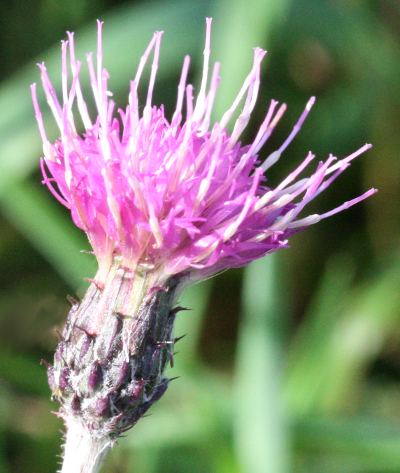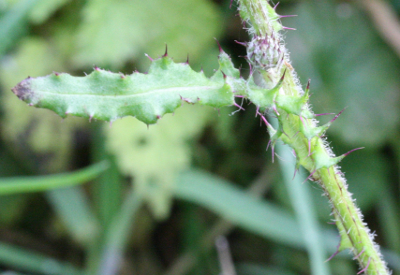Marsh thistle |


Flower head, leaf und stem of the marsh thistle
| Cirsium palustre (L.) Scop.: | |
| Blooming period: | June–September |
| Height: | 30–200 cm or higher |
| Flowers: | in heads, Ø of the heads 8-13 mm, stamens: 5, styles: 1 |
| Ray florets: | missing |
| Disc florets: | purple |
| Calyx: | transformed into a pappus |
| Stem leaves | alternate, elongated to lanceolate, pinnatifid, mucronate |
| Basal leaves: | missing at the flowering season |
Plant usually biennial, herbaceous, without taproot.
Stem erect, sometimes sparsely branched, villous to tomentose, foliated up towards the tip, thorny winged.
Stem leaves alternate, decurrent, long-oval, slightly sinuate to deeply pinnatifid, lobes wavy and thorny. Underneath slightly or dense long-haired, upper side glabrous or pilose. Leaves decreasing upwards in size, mostly sessile.
Flower heads rarely solitary, usually 2–8 ones in terminal, dense clusters, sessile or on up to 1 cm long, leafless, often tomentose stems. receptacle bristly.
The mucronate phyllaries are arranged imbricated in 5–7 rows. Outer ones lanceolate, inner ones linear-lanceolate, often tinged violet, sometimes slightly arachnoid. Involucre elliptical to bell-shaped.
The flower head consists entirely of purple or rarely white tubular florets, which are filiform, 11–13 mm long, hermaphrodite, 5-lobed and without chaffy leaves at the base.
After pollination by bees, bumblebees, wasps, or butterflies, the inferior ovary forms a 2.5–3.5 mm long nut fruit (achene), which is brown or yellowish and flattened. At the apex with about 10 mm long, feathery, off-white sailing hairs.
Cirsium palustre may form bastards with C. oleraceum, C. arvense, C. vulgare, C. spinocissimum, C. acaule, C. canum, C. heterophyllum, C. rivulare, C. tuberosum and C. dissectum.
| Floral formula: |
| * K=pappus [C(5) A5(connate)] G(2) inferior |
Occurrence:
Swamps,
bogs, wet meadows, damp forests, banks of ditches and rivers. Prefers
moist, acidic and nitrogen-poor locations.
Distribution:
Originally
Europe and Siberia, introduced in the US and Canada.